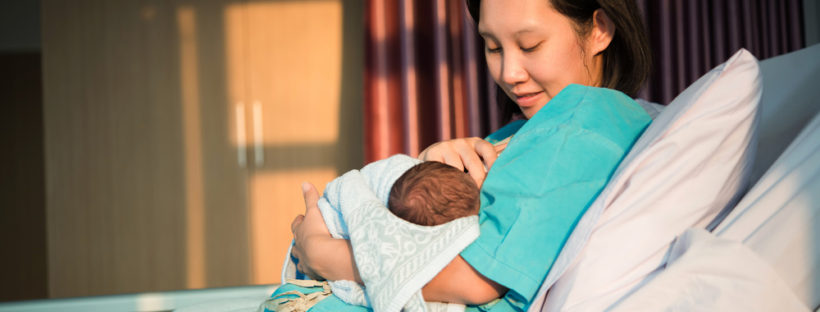Cheryl J. Bonecutter, RNC, WHNP-BC, MSN, DNP
Nancy Nurse walks into the hospital for her twelve hour shift like she has hundreds of times before in her eight year career as an obstetrical nurse. Tonight, like so many other nights, she contemplates if she will have an enough nurses to care for the ladies presenting in labor tonight. She dreads the thought of having another discussion with Dr. Kantwaite about delivering a baby before the 39th week and the evidence that has been presented to him multiple times by the nurses and chief of the department. The chief is so frustrated and tired of dealing with Dr. Kantwaite that he has stopped answering the calls from the nurses pushing this physician’s blatant noncompliance with safety and best practice through their chain of command. Nancy documents and reports these occurrences to her nurse manager who throws up her hands, asking what can she do to resolve these problems. She knows through several candid conversations with her manager that there is approval to hire only a limited number of staff in the budget and she is always pressured regarding the productivity of the unit. The moment-to-moment operations of the labor and delivery unit is challenging at best. The needs of one patient turn into needs for two patients or more with the mother through recovery and the baby as they transition into life on their own.
Nancy Nurse has been assigned to care for a woman delivering an anencephalic baby. The family has requested that all resuscitation measures be used to save their baby despite discussions with the parents on the mortality of anencephalic babies from the neonatologist and obstetrician. Nancy realizes that Dr. Kantwaite is on call tonight and is already calling to induce a 37.3 week gestation primagravida patient. Her cervix is closed but he wants the nurse to insert cervadil to ripen her cervix and start Pitocin in the morning. Nancy has reviewed the prenatal record and finds no medical reason to induce this woman. Nancy is also in charge tonight and has had one of the nurses for her shift call in ill. This leaves them one nurse down tonight, giving her patient assignments as well as taking charge nurse responsibilities assisting the other nurses with their deliveries, transitioning babies and checking that the unit is stocked, paperwork is completed, staffing is evaluated for the next shift and all of the charge nurse assigned duties. Nancy has planned to attend the clinical excellence meeting in the morning to discuss a new medication reconciliation process the hospital wants to implement through the computer system. Moral distress, ethical dilemmas and ethical distress are all difficulties that nurses face on a daily basis in virtually every healthcare environment. These quandaries can influence nurse engagement, job satisfaction, turnover, nurse attrition, patient safety and quality of care.9,23 The personal impact of moral distress can result in feelings of frustration, anger, anxiety, guilt, and loss of self-worth, depression, nightmares, resentment, sorrow, helplessness and powerlessness.23 Rather than experience these negative feelings, they may choose to transfer to another position or even leave the nursing profession in order to escape this distress.13(p258),23
Morals and ethics, although frequently used interchangeably, are different in definition. The simple difference to distinguish morals and ethics is that “morality is about making the correct choices while ethics is about proper reasoning”.16 Healthcare systems across the nation, in some form or fashion, have an ethics committee, yet morals committees or boards are absent.
Moral distress and how it effects the overall nursing engagement has been understudied and is frequently the “elephant” no one wishes to discuss in the organizational structure of healthcare. Many factors and situations influence moral distress including staffing, physician practice, nursing practice, ethical climate, violence in the workplace and organizational policies but since moral distress in based on individual values and perceived obligations this varies from nurse to nurse.8 Nursing turnover, job satisfaction, quality of care, nurse attrition, caring attitudes, moral sensitivity and overall nurse engagement can be affected by moral distress. Moral distress and ethical distress are continuing to be utilized interchangeably in research and education. Ethics training focuses on ethical dilemmas and principles and may not include the tools needed to minimize the effects of the moral residue. The American Association of Critical Care Nurses has developed the “4 A’s”. Ask if you are feeling moral distress, Affirm your feelings, Assess and put the facts together and Act or create a plan and implement it.8 Other strategies that have been utilized include speaking up, be deliberate and accountable, build support systems and focus on changes in your environment at work. Get educated on moral distress and get everyone involved. Get down to the roots and develop polices, plan an inservice to train others.8
As we move toward improving our professional satisfaction with our work, improving quality of patient care and expanding our roles in healthcare; we must address the needs to diminish moral distress through effective tools that are easily accessed, supported by our institutions and professional organizations. We know that how we engage in our work can be crucial to our outcomes. Breaking down barriers in achieving our greatest work satisfaction, placing our mission first for our patients, developing a professional practice model and implementing tools to assist us with dealing with our moral distress will bring us closer to our purpose of caring.
 Dr. Cheryl Bonecutter has been a registered nurse for over thirty years, and a Nurse Practitioner for over twenty years, specializing in Women’s Health, NICU, and Pediatrics. She received her ADN degree from North Central Technical College (nka North Central State College) in Mansfield, Ohio, and thereafter, achieved her certification as a Women’s Health Nurse Practitioner from the University of Wisconsin-Milwaukee. After completion of her BSN, Cheryl attained her MSN from Drexel University in Philadelphia, and followed that with a Doctor of Nursing Practice (also from Drexel University), graduating Summa Cum Laude as to both advanced degrees.
Dr. Cheryl Bonecutter has been a registered nurse for over thirty years, and a Nurse Practitioner for over twenty years, specializing in Women’s Health, NICU, and Pediatrics. She received her ADN degree from North Central Technical College (nka North Central State College) in Mansfield, Ohio, and thereafter, achieved her certification as a Women’s Health Nurse Practitioner from the University of Wisconsin-Milwaukee. After completion of her BSN, Cheryl attained her MSN from Drexel University in Philadelphia, and followed that with a Doctor of Nursing Practice (also from Drexel University), graduating Summa Cum Laude as to both advanced degrees.
Cheryl has been active with numerous agencies and organizations, including the March of Dimes, AWHONN, and Sigma Theta Tau. In support of women’s and children’s health policy, she has provided testimony to various committees of the Ohio, South Carolina and Texas legislatures, and has served on several local and state advisory boards.
Through her career, Cheryl has worked the entire vertical spectrum of Women’s Health, from bedside to provider to administration, and is currently working as a Nursing Administration consultant with Healthtrust in the Houston, Texas area.
References
- Advisory Board Company. Engaging the Nurse Workforce: Best Practices for Promoting for Promoting Exceptional Staff Performance. Washington, DC: Advisory Board Company; 2007.
- Bakibinga, P., Vinje, H., & Mittelmark, M. (2012, February 20) Factors contributing to job engagement in Ugandan nurses and midwives. 2012 March 29. International Scholarly Research Network Volume 2012.
- Baldrige Performance Excellence Program. (8 March 2012). Retrieved 4 March 2013 from http://www.nist.gov/baldrige/about/baldrige_faqs.cfm
- Bjarnadottir, A. (2011). Work engagement among nurses in relationally demanding jobs in the hospital sector. Nursing Science (Vard/Norden). 2011, March; Publ. No. 101, Vol. 31, No. 3: 30-34
- Corley, M.C., Elswick, R.K., Gorman, M., & Clor, T. (2001, January). Development and evaluation of a moral distress scale. Journal of advanced nursing, 3(2), 250-257.
- Corley, M. & Selig, P. (1992). Nurse moral reasoning using the nursing dilemma test. Western Journal of Nursing Research. 1992; 14(3): 380-388
- Elpern, EH., covert, B., Kleinpell, R. (2005) Moral distress of staff nurses in a medical intensive care unit. American Journal of Critical Care; 14(6): 523-30.
- Epstein, E.G., Delgado, S.(2010, Sept 30) Understanding and addressing moral distress. OJIN: The Online Journal of Issues in Nursing. Vol. 15, No. 3, Manuscript 1. Retrieved 3 March 2013 from http:www.nursingworld.org/MainMenuCategories/EthicsStandards/Courage-and-Distress/Understanding-Moral-Distress.html
- Ganz, F. & Berdovitz, K. (2011). Surgical nurses’ perceptions of ethical dilemmas, moral distress and quality of care. Journal of Advanced Nursing. 2011, October 22; pp. 1516-1525
- Hamric, A., Borchers, T., & Epstein, E. (2011 April 14) Moral distress and ethical climate in nurses and physicians in intensive care unit (ICU) settings. Retrieved 8 February 2013 from http://www.virginia.edu/inauguration/posters/2.81.Biosciences.Hamric.Borchers.pdf
- Jameton, A. (1984) Nursing Practice: The Ethical Issues. Prentice Hall, Englewood Cliffs.
- Jones, C.B. & Gates, M. (2007) The costs and benefits of nurse turnover: A business case for nurse retention. OJIN: The Online Journal of Issues in Nursing. 12(3).
- Lawrence, L. (2011) Work engagement, moral distress, education level, and critical reflective practice in intensive care nurse. Nursing Forum. 2011, October-December; 46(4): 256-268
- Magnet Recognition Program Overview. (2013) American Nurses Credentialing Center; Retrieved 10 March 2013 from http://www.nursecredentialing.org/Magnet/ProgramOverview
- Malmin, M. (2012, April) Changing police subculture. FBI Enforcement Bulletin. Retrieved 9 March 2013 from http://www.fbi.gov/stats-services/publications/law-enforcement-bulletin/april-2012/changing-police-subculture
- Morals vs ethics: the problem with trolleys. (13 December 2010). The Philosopher’s Beard. Retrieved 3 March 2013 from http://www.philosophersbeard.org/2010/10/morality-vs-ethics.html
- Nathaniel, AK.(2006) Moral reckoning in nursing. Western Journal of Nursing Research. 28: 419-38
- Pauly, B., Varcoe, C., Storch, J. & Newton, L. (2009). Registered nurses’ perceptions of moral distress and ethical climate. Nursing Ethic. 2009; 16(5)
- Rivera, R., Fitzpatrick, J., & Boyle, S. (2011, June). Closing the RN engagement gap. The Journal of Nursing Administration. 2011; 41(6):265-272
- Schaufeli, W. B., Salanova, M., Gonzales-Roma, V., & Bakker, A.B. (2002). The measurement of engagement and burnout: A two sample confirmatory factor analytic approach. Journal of Happiness Studies, 3, 71-92.
- Simpson, M. (2008 July 8). Predictors of work engagement among medical-surgical registered nurses. The Journal of Nursing Research. 2009 February; 31(1):44-65
- Wilkinson, J.W. (1987/1988). Moral distress in nursing practice: Experience and effect. Nursing Forum, 23(1), 16-29.
- Zuzelo, P. (2007). Exploring the moral distress of registered nurses. Nursing Ethic. 2007; 14 (3) retrieved from: http://www.lasalle.edu/schools/snhs/content/pdf/moraldistresss.pdf
 Kerry S Foligno MSN RN CLC
Kerry S Foligno MSN RN CLC


 Shelley Thibeau, PhD, RNC, is the Director of the developing Mothers’ Milk Bank of Louisiana. As a NICU nurse for 38 years, her interest in breastmilk has expanded to exploring breastmilk immunology associated with preterm infant health.
Shelley Thibeau, PhD, RNC, is the Director of the developing Mothers’ Milk Bank of Louisiana. As a NICU nurse for 38 years, her interest in breastmilk has expanded to exploring breastmilk immunology associated with preterm infant health.
 Tasha Poslaniec has been a registered nurse for 17 years. She has been working in obstetrics for over a decade and is currently a Perinatal Quality Review Nurse and Childbirth Educator.
Tasha Poslaniec has been a registered nurse for 17 years. She has been working in obstetrics for over a decade and is currently a Perinatal Quality Review Nurse and Childbirth Educator.
 Deirdre Wilson, Senior Editor for UbiCare, is an award-winning writer and editor with 30 years’ experience researching and writing on a wide range of health, wellness and education topics for newspapers, magazines and a news wire service.
Deirdre Wilson, Senior Editor for UbiCare, is an award-winning writer and editor with 30 years’ experience researching and writing on a wide range of health, wellness and education topics for newspapers, magazines and a news wire service.
 Lori is an American Neonatal Intensive Care nurse that has made her way to Sweden. Her passion is maternal and infant education. She incorporates her years of work in maternal and infant health with a passion for wellness through her Prenatal Yoga, Mommy & Me Yoga, and Developmental Infant Massage classes in Gothenburg, Sweden. Follow her adventures on
Lori is an American Neonatal Intensive Care nurse that has made her way to Sweden. Her passion is maternal and infant education. She incorporates her years of work in maternal and infant health with a passion for wellness through her Prenatal Yoga, Mommy & Me Yoga, and Developmental Infant Massage classes in Gothenburg, Sweden. Follow her adventures on 
 Dr. Cheryl Bonecutter has been a registered nurse for over thirty years, and a Nurse Practitioner for over twenty years, specializing in Women’s Health, NICU, and Pediatrics. She received her ADN degree from North Central Technical College (nka North Central State College) in Mansfield, Ohio, and thereafter, achieved her certification as a Women’s Health Nurse Practitioner from the University of Wisconsin-Milwaukee. After completion of her BSN, Cheryl attained her MSN from Drexel University in Philadelphia, and followed that with a Doctor of Nursing Practice (also from Drexel University), graduating Summa Cum Laude as to both advanced degrees.
Dr. Cheryl Bonecutter has been a registered nurse for over thirty years, and a Nurse Practitioner for over twenty years, specializing in Women’s Health, NICU, and Pediatrics. She received her ADN degree from North Central Technical College (nka North Central State College) in Mansfield, Ohio, and thereafter, achieved her certification as a Women’s Health Nurse Practitioner from the University of Wisconsin-Milwaukee. After completion of her BSN, Cheryl attained her MSN from Drexel University in Philadelphia, and followed that with a Doctor of Nursing Practice (also from Drexel University), graduating Summa Cum Laude as to both advanced degrees.
 Kate McNair is a women’s health nurse practitioner & PhD student at Boston College. She also maintains clinical practice as an OB/GYN RN at a community health center in Roxbury, MA. Follow her on Twitter
Kate McNair is a women’s health nurse practitioner & PhD student at Boston College. She also maintains clinical practice as an OB/GYN RN at a community health center in Roxbury, MA. Follow her on Twitter 
 Michael Burke was born in Boston and raised in Carlisle, MA by his parents Kate and Jim. He attended Concord-Carlisle High School and went on to earn a BA in Anthropology and a minor in Journalism from The George Washington University in Washington DC, where he also served as captain of the division 1 men’s soccer team. Currently a student nurse in his final semester at MGH Institute of Health Professions, Mike hopes to continue to progress as a student and future nurse by providing the best care possible to his patients.
Michael Burke was born in Boston and raised in Carlisle, MA by his parents Kate and Jim. He attended Concord-Carlisle High School and went on to earn a BA in Anthropology and a minor in Journalism from The George Washington University in Washington DC, where he also served as captain of the division 1 men’s soccer team. Currently a student nurse in his final semester at MGH Institute of Health Professions, Mike hopes to continue to progress as a student and future nurse by providing the best care possible to his patients.
 Liz has over 25 years of Women’s and Children’s experience and has devoted her professional career to the care of women and children with roles as a staff nurse, nursing educator and most recently executive leadership. She has presented nationally on patient experience and mentoring new nursing leaders. In 2008, Liz was named to the Great 100 Nurses of North Carolina, and is a member of Sigma Theta Tau. In addition to her clinical work and expertise, Liz has taught at the baccalaureate and graduate levels at East Carolina University College of Nursing. She is board certified as a Nurse Executive by the American Nurses Credentialing Center.
Liz has over 25 years of Women’s and Children’s experience and has devoted her professional career to the care of women and children with roles as a staff nurse, nursing educator and most recently executive leadership. She has presented nationally on patient experience and mentoring new nursing leaders. In 2008, Liz was named to the Great 100 Nurses of North Carolina, and is a member of Sigma Theta Tau. In addition to her clinical work and expertise, Liz has taught at the baccalaureate and graduate levels at East Carolina University College of Nursing. She is board certified as a Nurse Executive by the American Nurses Credentialing Center.
 Lynn Erdman, MN, RN, FAAN,
Lynn Erdman, MN, RN, FAAN,